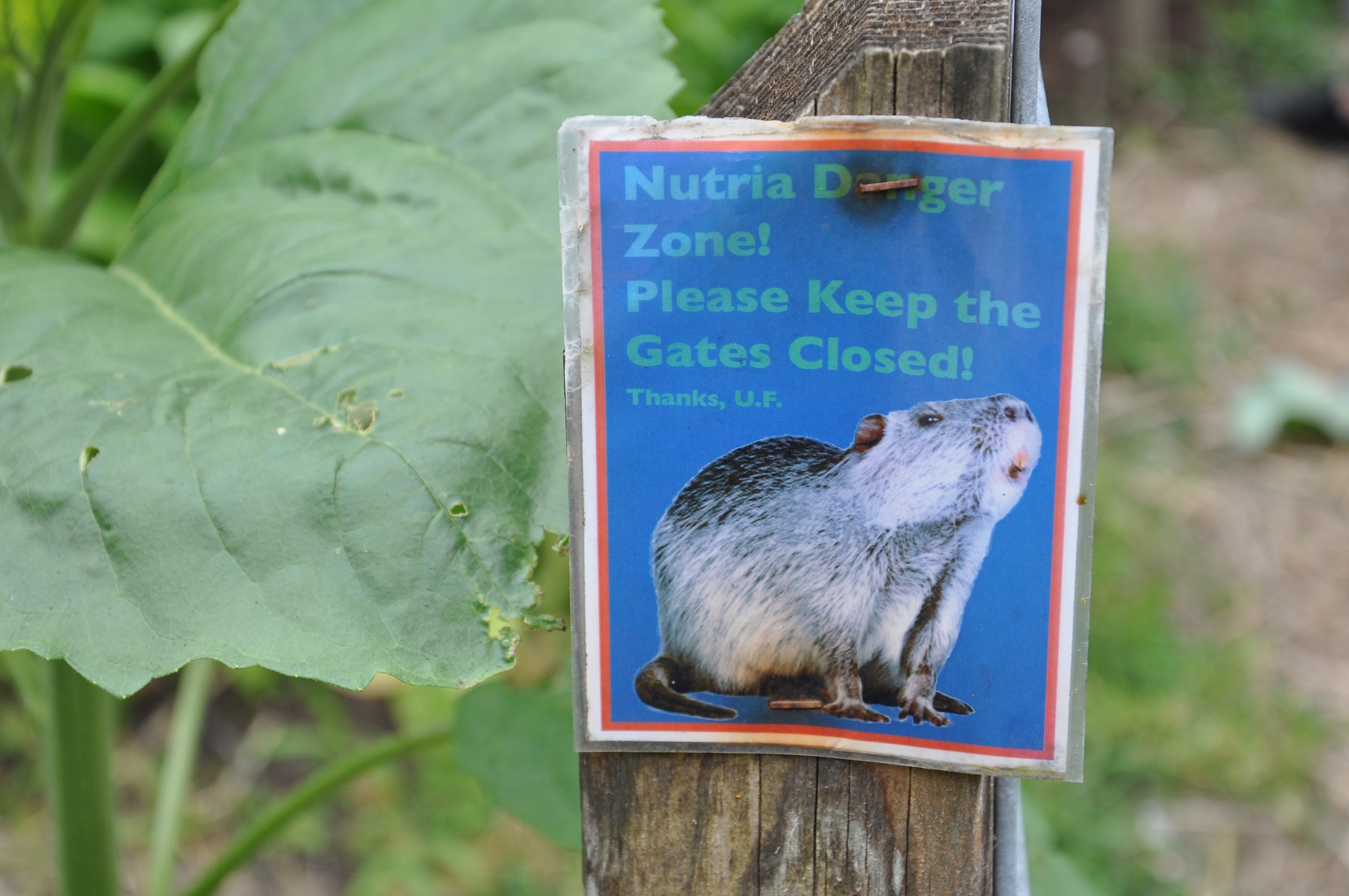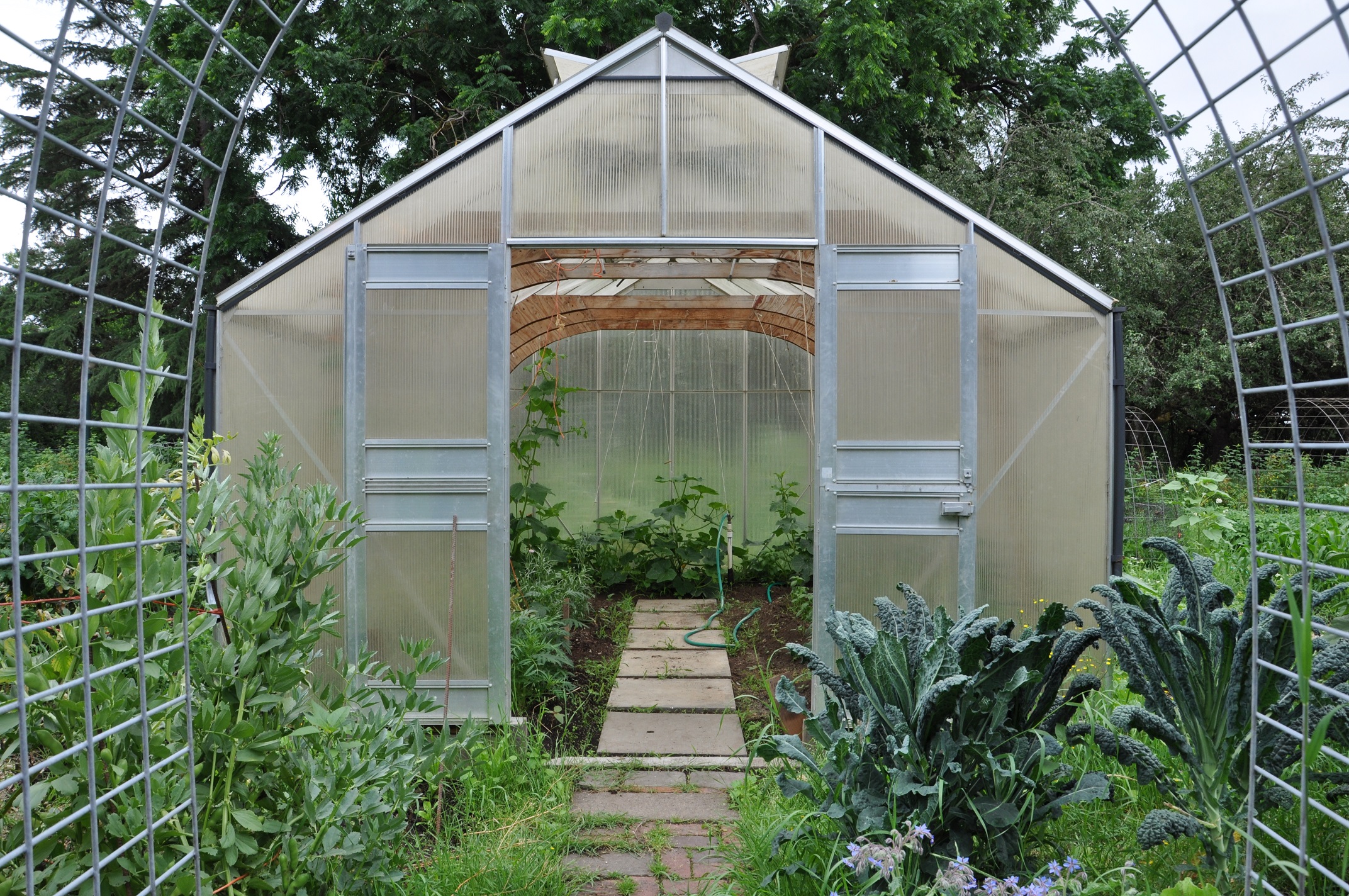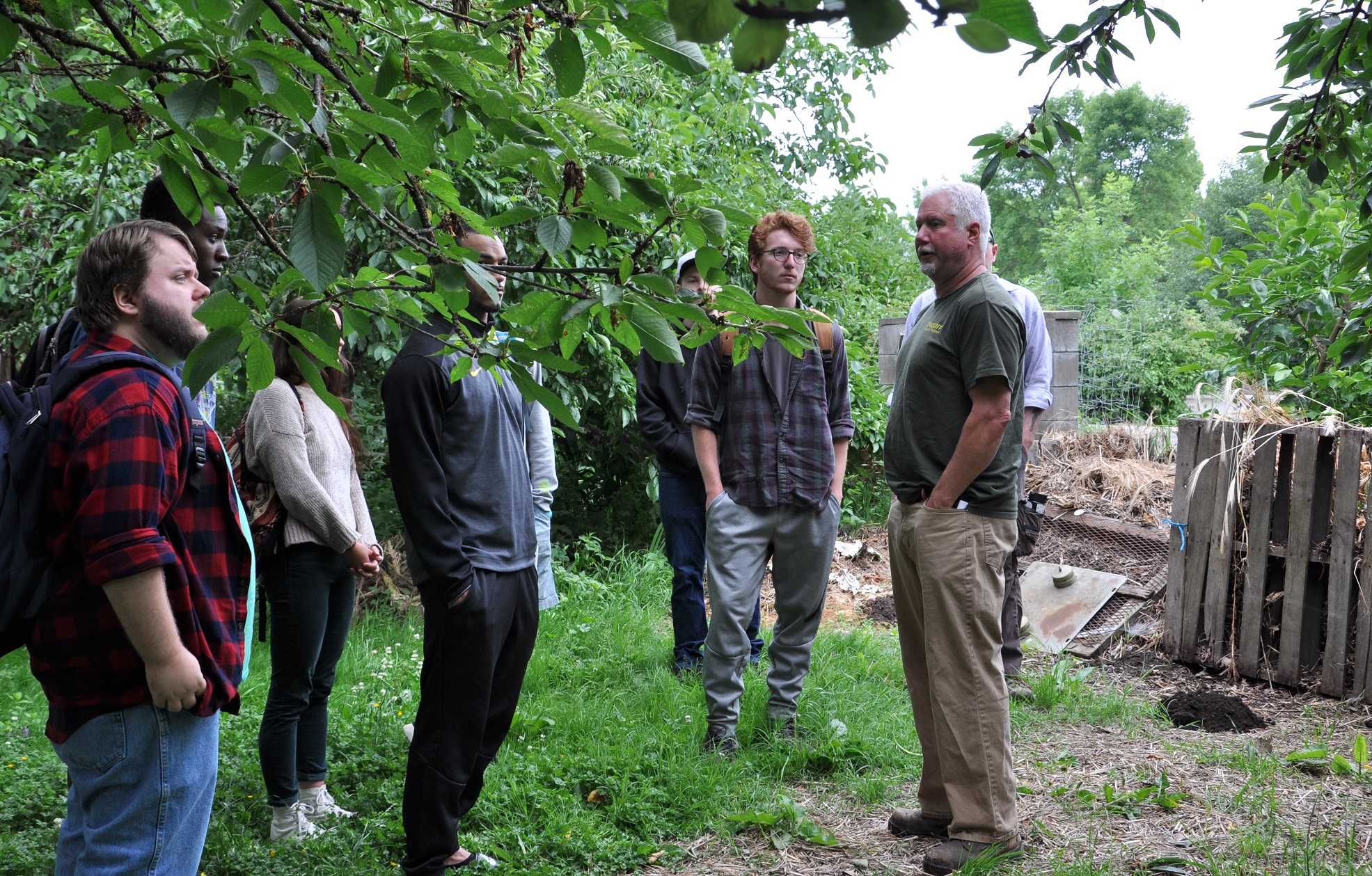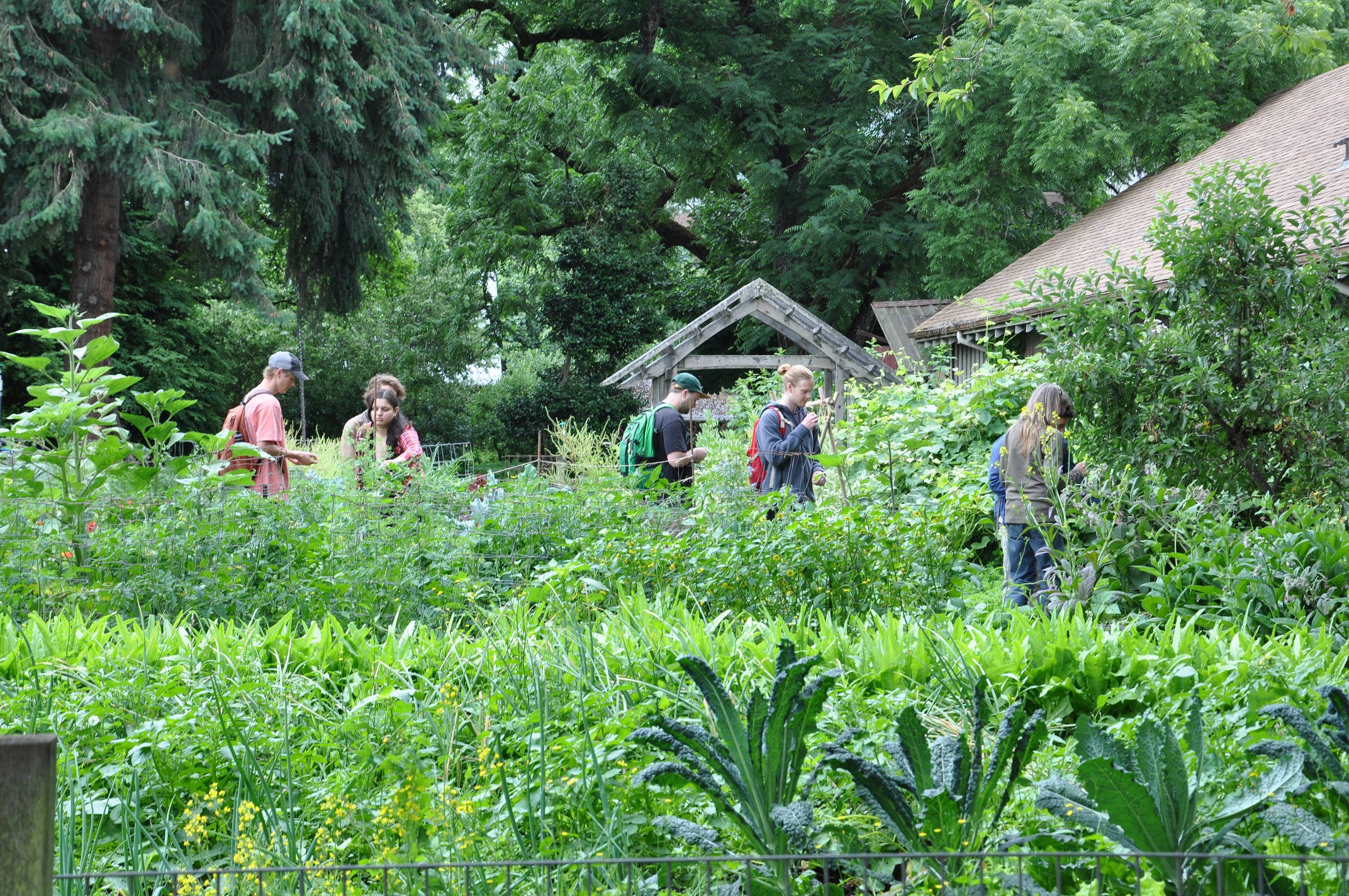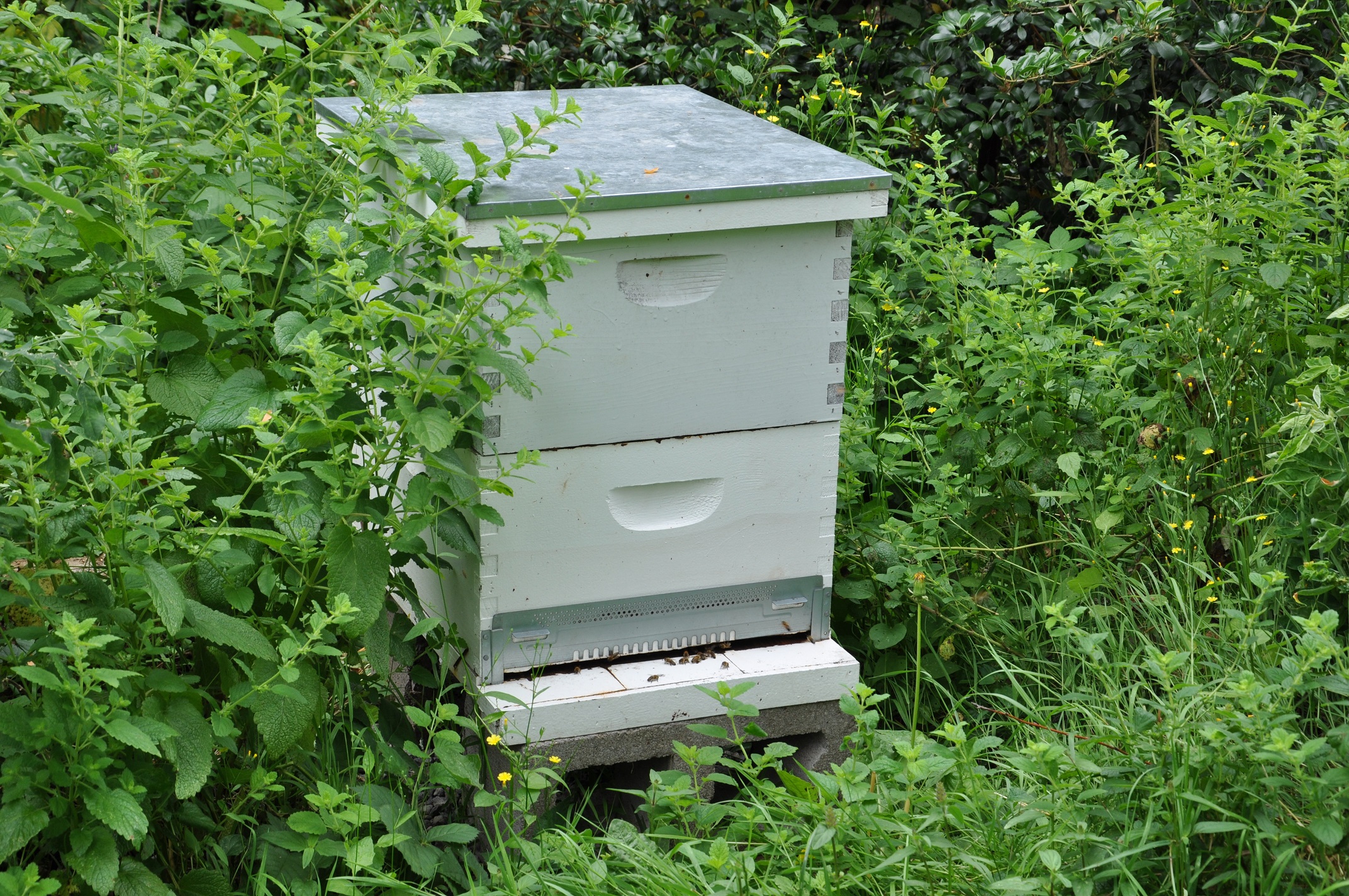Tour of the Urban Farm
A Tour of the Urban Farm (Ann Bettman et al.)
The Millrace
The Millrace was originally diverted from the Willamette River (which you would cross over on the Autzen footpath if you continued along the path) to power the mills and distilleries that were located further downstream toward downtown. Now the Millrace is rather stagnant; it receives a lot of run-off from the street and parking lots of East Eugene and is one of the most polluted water bodies in Lane County, especially down stream from the duck pond area. (The ducks, by the way, are very good for the Farm, providing a slug patrol service free of charge!) The big trees along the Mill Race are black walnuts. Their nuts are encased in very tough shells and can be delicious, but are hard nuts to crack. We have worked to stabilize the edge over the years but it is eroding away. We transplanted some mint, buttercups, comfrey and other aggressive plants to try to hold the edge. You might see an animal called a nutria which was imported from South America for fur and has now “naturalized” and is considered a major agricultural pest in the region. Nutria look like a large muskrat (or rat) with large orange teeth. They are not timid and are often out in the day, where they travel along ditches and waterways and feed on our crops.We put up the raspberry fence with hopes of deterring them but they enter through the open entrances to the Farm and cause damage to plants outside the protective fenced areas.
There are five apple trees here at this corner of the Farm and has been called The Five Apple Gateway, dating back before the bike path changed the entrance to the garden.
The vegetable beds on either side of the circle, and the Greenhouse
These are called “raised beds”. They are mounded up to improve the drainage.We are fortunate at the Farm to have really good soil (Class 1 agricultural soil) and our raised beds help keep the beds well drained so that we can work the beds early in the spring. Raised beds also provide air space (pore space) in the soil that is very important for roots to grow and for microorganisms to breathe. Making raised beds would be even more important in areas where the soil is poorly drained. Most of the Eugene area has poorly drained clay soil- except along the river terraces where there is good, well drained loamy soil.
Reach down and feel the soil, run your fingers in the soil…this is what good soil feels like. The fact that you can easily push your fingers down into the soil indicates how light and fluffy it is. Soil of this quality is considered to have ‘good tilth’ and much of what we do is intended to maintain this characteristic. Toward this end, we avoid stepping onto the planting beds as stepping on the beds compacts the soil, which is not good for the soil organisms or for the roots of the plants that are growing in the beds. We respectfully call this “soil,” not dirt. Soil is one of our most precious resources and it is alive with lots of micro and macro organisms.
In 2011, we built a the greenhouse in this central area to help us extend our planting seasons. Warm weather crops and propagation happens in this space.
The Red Pole Circle
This is the center of the “old’ or “main’ part of the Urban Farm. Years ago, someone read the “lei lines” (the energy lines which show you where energy vortices are) and indicated that this is the center of the Farm’s energy. So this is a special meeting space for class or any time. Much of what we do at the Farm revolves around solar energy, specifically, how plants use the energy from the sun to photosynthesize. There are 13 red poles. The number thirteen celebrates the lunar cycle. There are 13 cycles of the moon in one year. For some people, the red poles honor the female and male energy- red to celebrate women’s monthly cycle and poles as a phallic male symbol. In a sense, this heart of the garden is a solar/lunar female/male celebration.
In the past there were perennial flowers planted around the circle. Lately we have transformed the circle into a “crop circle”- using cover crops in the fall and sunflowers and beans or corn in the summer. This changes with the seasons.
The Old Greenhouse (Club House)
We use the greenhouse for starting seeds, growing up seedlings, storage and as a “club house.” Work gloves, seeds, pruners and tools are inside the greenhouse. Fertilizer is in the galvanized can outside the greenhouse to the left of the door and planting soil is in the can to the right of the door. Shovels, rakes, hoes and trowels are stored in the outer sheds.
The Kiln Area
The very grand timber framed structure was built to house a wood fired ceramics kiln that was dismantled in 2013. Some folks refer to this as ‘the temple.’ There are other kilns remaining that belong to the ceramics department. We work cooperatively with them and other departments over here on the North Campus site (fine arts, painting, sculpture, metal smithing, and architecture). Sometimes, it is a little hard when everyone has her/his own project going on but the focus on doing things/hands on learning and the interdisciplinary nature of the North site are very important to the ambiance of our place.
The Woodshop
The large building that defines the north edge of our main garden area is the furniture building woodshop and product design studio. Architecture students use this shop in conjunction with a studio where they design and build furniture. The large, very loud machine at the east side of the building is a dust collection system that vacuums sawdust from the shop. There is often composite lumber being milled in the shop so we cannot use this sawdust in the garden.
The Universally Accessible Bed
This bed was originally designed so that people in wheelchairs can garden comfortably. It is designed to be used by people using wheel chairs and for people who find it difficult to bend down and work in the beds, but in fact, everybody likes to work in this structured, elevated bed. This also serves as a useful meeting area during work sessions.
The Lynn Matthews Memorial Orchard
There are cherry trees (the biggest ones), apple trees and pears (the ones closest to the kiln area) in the Lynn Matthews Orchard. Lynn Matthews was a very active and wonderful teaching assistant at the Urban Farm in late 1970’s. She was killed in an accident, (in a truck accident- not at the Farm) and after the Memorial Service, the department of Landscape Architecture converted this former gravel parking lot into this orchard. Her parents very generously gave the Farm an endowment fund which has been critical to the survival of the Farm. This area is recognized by the campus planning office as a ‘sacred space’ in their campus pattern language.
The Compost Area
This is the heart of the farm’s fertility program. We make all of our own compost using the spent plants from the garden, manure (horse or chicken, brought in from local farms) and leaves and/or straw. We also accept regular deliveries of pre-consumer food waste from the campus zero waste program. This is a great resource. Everyone learns how to make compost.
The Coca Cola Lot
Directly to the east of the Compost area is a large open lot that used to be the site of a Coca Cola bottling plant. It is now a parking lot that services the Jaqua Academic Center. In the past we have used this area to pile debris and noxious weeds that we didn’t want on the Farm. This is no longer an option which is unfortunate, but we have been working with campus planning and facilities and are now using this edge as an example of urban edible landscaping. Perhaps ironically, the parking lot creates a sunny micro-climate along the Urban Farm’s eastern boundary. This has increased productivity in the fruit varieties that enjoy more heat.
The Straw Bale Circle
The Straw Bale Circle is our outdoor classroom. It appears and disappears according to our need for straw to mulch beds and to make compost. This is the site of the original Urban Farm House that was removed in 1990.The nearby red gate supports a grape vine that once grew on a trellis that was part of the farmhouse.We often use this space to celebrate seasonal events and there is usually a maypole marking the spot. Remnants of an old Cob wall can be seen in this area, as well. It was built by students during the HOPES conference in the late 90’s. Cob is a mixture of straw, clay and sand. It was waterproofed with linseed oil and beeswax, but little remains. It was designed and built as an exercise to give some spatial definition between the ceramics area and the Farm.
“New” Orchard (and the old vermicomposting area)
In the 1990’s, we had an intensive vermicomposting project which was designed to demonstrate food waste reduction. It was designed to accommodate food waste from the dorms but the university never bought into the system so it was then used as a vermicompost in situ demonstration project. We used food waste from 19th Street Cafe, the Street Fair etc. and layered it with rock dust and wood chips. This is an ideal habitat for earthworms who then process these materials and leave casings and very rich compost. Instead of using heat to compost, vermicomposting uses a biological process.Young fruit trees (apple, cherry, plum, Asian pear, European pear) were planted in the vermicompost area in the mid-90’s. This has become a very productive orchard.
The Back 40 Beds
While the beds in the old part of the Farm – or the front part of the Farm – have a lot of diversity, these beds in the ‘Back 40’ were once larger beds of favorite crops like corn, beans, squash and garlic/shallots in rotation. With the expansion of student enrollment, these beds are now used by student teams. Years back, we fenced in this area for broccoli family plants to protect them from nutria predation and this is still an issue. We also have permanent asparagus, cane fruit and artichoke beds back here.
The South Hedgerow
This hedgerow along the back fence was planted in 1999 in pawpaw, medlar, pineapple guava, fig, seaberry, elderberry, aronia, and ceanothus. It was sadly neglected and most was removed to make way for the new parking lot. Luckily, we were able to salvage some doomed plants ahead of the construction and they are now growing here.There are figs as well as a bay tree, a viburnum and an Elaeagnus tree.
The Bee Hives
Many years ago, Chuck Hunt in the Sociology Department and Peter Wetherwax, a Pollination Ecologist asked to place a beehive at the Urban Farm. This was the beginning of what has become our own honey bee program. Presently, we have two Langstroth hives at the far north end of the farm, a horizontal ‘kenya’ style top- bar hive within the fenced area of the back-40 and a vertical ‘Warre’ top-bar hive, that is south of our clubhouse.
Our team leaders and other local beekeepers periodically give talks in the summer term about the importance of honeybees and pollinators and occasionally we harvest honey to share.

